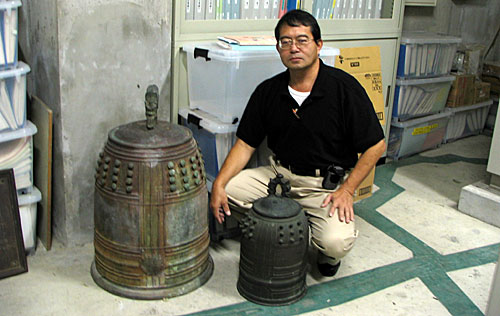Society works to put historic bells in sight
By David Allen, Stars and Stripes
Pacific edition, Thursday, October 11, 2007
KITANAKAGUSUKU, Okinawa
An Okinawa temple bell dating from the 15th century is homeless.
Returned to Okinawa sixteen years ago, after the Buddhist bell was taken and displayed as a war trophy at Virginia Military Institute, the Dai Shouzen-ji bell now stands in the basement of a rehabilitation center for the handicapped, placed near the building’s boiler.
It’s just another disappointing chapter in the sad history of the 450-pound bell, said Shizuo “Alex” Kishaba, president of the Ryukyu-America Historical Research Society. The organization campaigned for years to get the bell — cast in 1456 — returned to Okinawa.
|

David Allen / S&S
Shizuo “Alex” Kishaba, president of the Ryukyu-America Historical Research Society, squats next to the Dai Shouzen-ji and a smaller temple bell in the basement of a rehabilitation center for the handicapped.
|
The bell was seized by U.S. Marines during the Battle of Okinawa in the spring of 1945. Lt. Gen. Lemuel C. Shepherd Jr. donated the bell to VMI, his alma mater, where it was prominently displayed in 1955.
It stands about three feet high and is inscribed with praises to Buddha and Ryukyuan King Sho Taikyu. One engraved phrase says the bell’s “deep and solemn sounds will wake people from delusion and show how ruler and ruled should stand together.”
In 1991, retired Marine Maj. Gen. James L. Day led the effort by Kishaba’s group to return the bell to Okinawa. Day, who received the Medal of Honor for his actions as an enlisted Marine during the Battle of Okinawa, had been successful four years earlier in negotiating the return of another temple bell that was taken from Okinawa by Commodore Matthew Perry in 1853 and kept on display at the U.S. Naval Academy in Annapolis, Md.
That bell, called Gokoku-ji, is now on display in the Okinawa Prefectural Museum. The Dai Shouzen-ji bell was supposed to be displayed in Shuri Castle, which was rebuilt in 1992.
“But there was a breakdown in communications and the bell, instead, was kept at the Shuri Citizens Hall,” Kishaba said.
That’s where it was late last year, when an American creating a documentary on Japanese temple bells taken by U.S. soldiers as souvenirs came to Okinawa.
“When the filmmaker, Paul Creager, visited the Shuri Citizen’s Hall, he called me up and said, ‘Alex, if I shoot this you’re not going to get many other bells back,’” Kishaba said.
“The bell had been removed from its prominent display and was sitting on the floor in a stairwell behind a telephone box,” Kishaba said. “But what really stoked my temper was that it was chained to the telephone stand. They were using the bell to secure the telephone box.”
Kishaba went to the restoration committee and demanded the bell back.
“I asked the chairman of the committee if the bell was secured to the phone box to make sure the bell would not be stolen, or was it the other way around?” he said. “He said it was to make sure the phone wasn’t stolen, and I told him that’s why I wanted it back. You don’t treat religious artifacts that way.”
That was a year ago. Since then Kishaba has been seeking a permanent home for the bell, “someplace where people could see it and ring it.”
For a few weeks, it was placed in a park in the Oku community in northern Okinawa Naha, but Kishaba received reports that it was not being cared for and was afraid it would be stolen.
“There’s a serious problem in Japan these days with people stealing objects that can be sold as scrap metal,” he said. Since then, the bell has been in the basement of the rehabilitation building.
“What I’d like to see is the bell placed in a prominent spot in the main lobby of the Okinawa Prefectural office building, where it can be seen by hundreds of people every day — be a sort of ambassador,” Kishaba said.
He said he sent his request to prefectural officials, but a prefectural spokesman last week said they had no record of it.
On Okinawa, such historical assets are the purview of the cultural division of the Okinawa Prefectural Board of Education. A team from the division visited the Shuri Community Hall in November 2005 to check the bell, and was appalled to find it sitting under the staircase.
“It made us wonder whether they thought the bell was important,” said Suzuko Shimabukuro of the cultural division. She told the community hall officials that the bell should be placed in a prominent display.
She said she was unaware of Kishaba’s request.
In the meantime, Kishaba said he will keep it until he finds a proper home. He wants assurances the bell will not be neglected.
“After the government lied about the Gokoku-ji bell and put it on display in the museum instead of the prefectural hall, I want to be sure this bell does not meet the same fate — or worse,” he said. “The museum already has 12 such bells of cultural significance. Five or six are in displays, the others are in storage next to a garbage collection point.”
Stars and Stripes reporter Chiyomi Sumida contributed to this report.
[BACK] to ClickOkinawa.com
